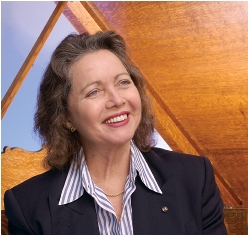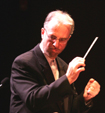
Zwilich Reigns in Hamilton
Like its premiere
in East Lansing, Michigan in February 2000, Saturday night’s (March 6)
performance of Ellen Taaffe Zwilich’s Symphony No. 4 by the Hamilton Fairfield
Symphony Orchestra led by Paul John Stanbery was a happening. The concert took place at New Life Vineyard
Church in Hamilton and included members of the HFSO Chorale, a children’s
chorus from St, Peter in Chains School and the Hamilton Public Schools and hand
bell ringers from St. Peter in Chains Catholic Church and The Presbyterian
Church in Hamilton.


Echoing the
subtitle of Zwilich’s Symphony, “The Gardens,” there were plants in the foyer –
exotic ones provided by the Turrell Herbavorium of Miami University (Oxford)
and the Fitton Conservatory of Miami’s Hamilton campus.
There were tables to sign up for the HFSO’s “Meters
for Mozart” 5K Run/Walk April 17 in Joyce Park in Hamilton, sign up sheets to
volunteer or become a member of the HFSO Guild, order forms for a CD of the evening’s
concert and other HFSO concerts (Tri-State Productions), refreshments at intermission and an overall
flurry of activity.

Zwilich, winner of the Pulitzer Prize in 1993
for her Symphony No. 1 (the first woman to do so), attended the concert, having
been introduced to members of the community earlier in the day at a
meet-the-composer event in Hamilton. Gracious
and charming, she spoke to the audience after the concert, accepted a
proclamation from Hamilton Mayor Pat Moller – March 7 is “Ellen Taaffe Zwilich
Day” in Hamilton --signed autographs and met guests at a post-concert reception.
In addition
to Zwilich, who celebrates her 70th birthday this season, there was
a debut by pianist Kenneth Danielson, 2009-2010 winner of HFSO’s David L. Belew
Young Artist Competition and -- good grief -- would you believe Peanuts?
Yes. Danielson
bowed in with Zwilich’s “Peanuts Gallery” for piano and orchestra, a set of
five portraits of Charles Schulz characters, composed for the family concert
series at Carnegie Hall in New York in 1997.
(Zwilich was a friend of the artist, who featured her in several “Peanuts”
cartoons. "Peanuts Gallery" is dedicated to him.)

The concert,
without more, would have been an event, 10th in the series of David
L. Belew American Masters Concerts begun by the HFSO in 1999. With headliner Zwilich, it was a feather in
the cap of music director Stanbery, who snagged her with the aid of the
National Endowment for the Arts. Who
says public funding of the arts only benefits elite arts organizations?
The
all-Zwilich program included her 1993 Concerto for Horn and String Orchestra
with HFSO principal hornist Todd Fitter.
It opened with her 1998 “Upbeat!” for orchestra, and the two works could
not have been more different. Where “Upbeat!”
was just that, the Horn Concerto was a dark, even angry work reminiscent of
Shostakovich. “Upbeat!” a brief curtain
raiser, was a kind of Bach meets Aaron Copland, a jazz-flavored invention that
put everyone in a good mood.
Commissioned by the great American hornist
David Jolley, the Horn Concerto makes considerable demands on the instrument
(Zwilich has described it as a tone poem with the horn as the hero). Fitter, who also performs with the Dayton and
Clermont Philharmonics, the School House Symphony and numerous other ensembles
throughout the region, soldiered valiantly in the Concerto, both technically
and expressively, exhibiting a wide range of pitch and tone color (open, stopped
and muted). The HFSO strings were an
effective partner though overall, the performance needed more rehearsal. (Also, program notes would
have been a welcome addition to the otherwise very generous program provided by
the HFSO for the concert.)
Danielson, a
senior at Talawanda High School in Oxford, demonstrated considerable presence,
even “cool,” in Zwilich’s “Peanuts.” He
worked hand-in-paw with Stanbery and the HFSO in “Snoopy Does
the Samba,” a delightful Brazilian rumble with lots of vibrant drumming. Zwilich's musical images are delightful, from
“Schroeder’s Beethoven Fantasy,” where she incorporates motives from
Beethoven’s Ninth Symphony and his piano concertos, to “Lucy Freaks Out,” a
mild-mannered to meltdown episode with orchestral shrieks as well as calmer moments.
Zwilich’s
Fourth Symphony received its second performance (ever) at this concert, not having
been played since its 2000 premiere by ensembles of Michigan State University
in honor of MSU’s famed botanical gardens.
About a half-hour long and scored for orchestra, chorus, children’s
choir and hand bell ensemble, it comprises four movements, “Litany of
Endangered Plants,” “Meditation on Living Fossils,” “A Pastoral Journey” and “The
Children’s Promise.” Why it has taken so
long for a second performance – in addition to the usual problem of bringing
new music into the repertoire – is puzzling, since it is so approachable, from
both a performer’s and a listener’s perspective, and so relevant to contemporary
life on our environmentally challenged planet.
One reason may be the forces required to perform it. Another may be that critical reaction to the MSU premiere was cool (too “accessible,” lacking in depth, etc.). This listener found it moving and stimulating. So what if it lacks complexity and is “easy on the ears?”
It opened, with a big triadic chord and a fanfare-like introduction.
The chorus recited a “litany”( in Latin) of endangered plants against a
colorful orchestral background, with pounding timpani and stinging gongs (to
call it a child of “Carmina Burana” might not be too far off the mark).
“Meditation
on Living Fossils,” a purely orchestral movement, evoked roots digging
laboriously through the ground. With
dark, mournful double basses, low flutes and stark dotted rhythms, it had a
doomed, “moldy” sound that died away at the end.
“A Pastoral
Journey” (meant to evoke forest vistas, Stanbery said) was big, percussion-rich
and multi-colored, with “leafy” glissandos (fingers sliding over the string), a
wealth of metal percussion (including handbells) and some fine solos by the
HFSO winds. The chorus intoned verses
from Matthew 6:28-29 (“Behold the lilies of the
field . . .”).
The children’s
voices took over sweetly in the final movement, asserting “We will protect our
heritage,” as the adults repeated their litany of threatened species amid the
ring of percussion and handbells. There
was a minimalist feel as the soft ending approached and all the voices joined
in the promise.
Zwilich’s
described her three-day visit to Hamilton as “an extraordinary experience,”
indicating “what a special place the arts hold” in this northern suburb of Cincinnati. She already has the Key to the City of
Cincinnati, by the way. The world
premiere of her “Millennium Fantasy” for piano and orchestra took place in Music
Hall in Cincinnati in September, 2000 with pianist Jeffrey Biegel and the Cincinnati
Symphony Orchestra led by former music director Jesus Lopez-Cobos. Her Violin Concerto was performed by
violinist Pamela Frank and the CSO led by guest conductor Junichi Hirokami in
April, 2000, also at Music Hall.
The Hamilton
Fairfield Symphony’s American Masters Concerts, which bring a distinguished
living composer to the community for a week each year, culminating in a concert
of his or her music, began with H. Owen Reed in 1999. Others have included Wallace DePue, James
Niblock, Thomas Benjamin, Robert Ward, Catherine McMichael and Philip Koplow.
Founded in
1951, the Hamilton Fairfield Symphony is a 75-member professional orchestra
that presents four to five concerts a year, including an annual Mozart
Festival. This year’s Mozart Festival is
April 17-25 at various locations in Butler County. For information, visit www.hfso.org